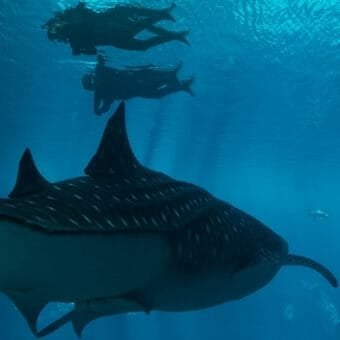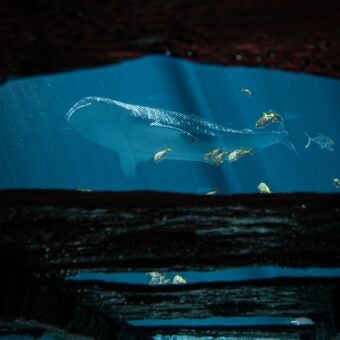-
Size
8 feet (2.4 m) -
Diet
Crustaceans, turtles, fish and stingrays -
Range
Atlantic ocean and eastern Pacific ocean -
Habitat
Shallow water
Physical Characteristics
- The goliath grouper reaches a length of 8 feet (2.4 m) and the largest published weight is 1003 lbs. (455 kg)
- The base of the soft dorsal and anal fins are covered with scales and thick skin.
- The juvenile goliath grouper, which is less than 39 inches (100 cm), is tawny or yellowish-brown in color with irregular darker brown vertical bands. The larger adult fish is gray or greenish with pale blotches and smaller dark brown or blackish spots scattered over the upper part of its head, body and pectoral fins.
Animal Fact
The goliath grouper is often seen at cleaning stations where cleaner fish remove parasites as part of a mutualistic relationship.
Diet / Feeding
- The goliath grouper feeds primarily on crustaceans, especially spiny lobsters, turtles, fish and stingrays.
- Few fish eat lobsters because of their size, but they are a favorite food of the goliath grouper.
- This species is an ambush hunter that feeds during the day, with increased activity during the low-light periods of dawn and dusk.
- It strikes with a quick lunge powered by its broad caudal fin and wide caudal peduncle. This is accompanied by the rapid expansion of its jaws and flaring of the gill covers, creating a vacuum that sucks the prey into its mouth. The prey is swallowed whole. The suction is strong enough to suck lobsters from their crevices.
Range / Habitat
- The goliath grouper occurs in the western Atlantic from Florida to southern Brazil, including the Gulf of Mexico and the Caribbean. It also is present in the eastern Atlantic from Senegal to Congo and in the eastern Pacific from the Gulf of California to Peru.
- This fish typically remains in shallow water, although a few individuals have been reported at depths of 280 feet (85 m).
- It is associated with rocky reefs, living in brackish and marine environments mostly in shallow, inshore areas. It can be found over rock, coral, or mud bottoms and sometimes in estuaries.
Reproduction & Growth
- Oviparous or egg laying fish.
Conservation Status
- This species is listed on the IUCN Red List as “Critically Endangered” and it is now protected in some areas.
- Populations began to decline in the 1960’s when recreational SCUBA divers would swim up to the fearless fish and spear it at close range.
- Harvesting was so excessive that, in 1990, an emergency ruling was enacted in the U.S. making it unlawful to harvest or possess goliath grouper.
Additional Information
- It can live to be about 37 years of age and possibly longer.
- The goliath grouper exhibits territorial behavior near its sheltered home in a cave or wreck. This consists of a “threat display” to intruders by opening its mouth wide and shaking its body or producing a loud booming sound (see below).
- The goliath grouper will produce loud “booms” when it is startled or cornered. It also produces similar sounds during courtship. Its swim bladder and surrounding muscles produce the sound. The booms are believed to be territorial warnings. Researchers have also heard juveniles in mangrove shallows boom before taking the bait. It is thought that the boom might be used to stun small prey.
- The goliath grouper will travel many miles for one or two months each year to mate in huge spawning aggregations at traditional breeding grounds. Individuals gather to spawn around the time of the full moon in August and September. As the male approaches the female, its entire forebody, from the pectoral fins forward, turns pale, contrasting sharply with the dark rest of the body. The female exhibits no significant color change.
- The goliath grouper eggs are released into open water. The eggs hatch into transparent larvae that quickly develop long spines and a large mouth. After drifting with the current for 25 to 45 days, the one-inch larvae settle to the bottom in shallow-water mangrove habitats where they hide while completing metamorphosis into juveniles.
- Large areas of mangrove forests are vital for the larvae and juveniles until they reach 30 lbs. (13.6 kg) because this habitat provides shelter under the deep mangrove shelves. The lack of this habitat in the eastern Caribbean is believed to be the reason for the limited population there. Little is known about juvenile growth rates, feeding behaviors, or habitat shifts as this grouper matures. The juvenile feeds exclusively on crustaceans.
- Due to short dive times at depths of 100 feet or more, there have been few recorded observations of the courtship of the goliath grouper. This has severely restricted researchers’ ability to study the reproductive behavior of the species.
- It is often seen at cleaning stations where cleaner fish remove parasites.
Sources
- www.fishbase.org
- Encyclopedia of Fishes, 2nd Edition.
- Reef Fish. Thresher, R. E.
- Fishes of the Tropical Eastern Pacific. Allen, G. R.
- Reef Fish Behavior. Deloach, N. and Humann, P., pgs. 43, 54, 103, 127, 231-238




